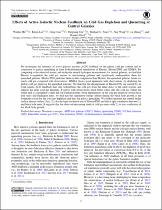| dc.contributor.author | Davé, Romeel | |
| dc.contributor.author | Ma, Wenlin | |
| dc.contributor.author | Liu, Kexin | |
| dc.date.accessioned | 2023-03-22T09:52:24Z | |
| dc.date.available | 2023-03-22T09:52:24Z | |
| dc.date.issued | 2022-12-27 | |
| dc.identifier.citation | Ma, Liu, K., Guo, H., Cui, W., Jones, M. G., Wang, J., Zhang, L., & Davé, R. (2022). Effects of Active Galactic Nucleus Feedback on Cold Gas Depletion and Quenching of Central Galaxies. The Astrophysical Journal, 941(2), 205–. https://doi.org/10.3847/1538-4357/aca326 | en_US |
| dc.identifier.issn | 0004-637X | |
| dc.identifier.uri | http://hdl.handle.net/10566/8643 | |
| dc.description | NSC | en_US |
| dc.description.abstract | We investigate the influence of active galactic nucleus (AGN) feedback on the galaxy cold gas content and its connection to galaxy quenching in three hydrodynamical simulations of Illustris, IllustrisTNG, and SIMBA. By comparing to the observed atomic and molecular neutral hydrogen measurements for central galaxies, we find that Illustris overpredicts the cold gas masses in star-forming galaxies and significantly underpredicts them for quenched galaxies. IllustrisTNG performs better in this comparison than Illustris, but quenched galaxies retain too much cold gas compared with observations. SIMBA shows good agreement with observations, by depleting the global cold gas reservoir for quenched galaxies. We find that the discrepancies in IllustrisTNG are caused by its weak kinetic AGN feedback that only redistributes the cold gas from the inner disks to the outer regions and reduces the inner cold gas densities. It agrees with observations much better when only the cold gas within the stellar disk is considered to infer the star formation rates. From dependences of the cold gas reservoir on the black hole mass and Eddington ratio, we find that the cumulative energy release during the black hole growth is the dominant reason for the cold gas depletion and thus the galaxy quenching. We further measure the central stellar surface density within 1 kpc (Σ1) for the high-resolution run of IllustrisTNG and find a tight correlation between Σ1 and black hole mass. It suggests that the observed decreasing trend of cold gas mass with Σ1 is also a reflection of the black hole growth. | en_US |
| dc.description.sponsorship | N/A | en_US |
| dc.language.iso | en | en_US |
| dc.publisher | American Astronomical Society | en_US |
| dc.subject | Physics | en_US |
| dc.subject | Astronomy | en_US |
| dc.subject | Astrophysics | en_US |
| dc.subject | Cosmology | en_US |
| dc.title | Effects of active galactic nucleus feedback on cold gas depletion and quenching of central galaxies | en_US |
| dc.type | Article | en_US |

